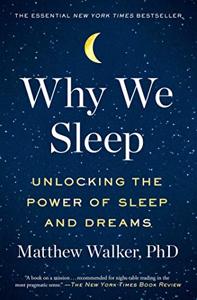
Want to learn the ideas in Why We Sleep better than ever? Read the world’s #1 book summary of Why We Sleep by Matthew Walker PhD here.
Read a brief 1-Page Summary or watch video summaries curated by our expert team. Note: this book guide is not affiliated with or endorsed by the publisher or author, and we always encourage you to purchase and read the full book.
Video Summaries of Why We Sleep
We’ve scoured the Internet for the very best videos on Why We Sleep, from high-quality videos summaries to interviews or commentary by Matthew Walker PhD.
1-Page Summary of Why We Sleep
Overview
Matthew Walker’s book, Why We Sleep: Unlocking the Power of Sleep and Dreams, examines how sleep is important for health. Many people don’t understand that sleep is crucial to their well-being. However, it can help them be healthier and more productive.
Sleep is a natural process that most animals do. Humans have three stages of sleep: light, deep and REM (rapid eye movement). Dreams occur during REM sleep, which is only present in land-dwelling mammals and humans.
Sleep has several phases. The purpose of deep sleep is to organize memories, solidify new knowledge, and remove unnecessary memories. In REM sleep, the brain seeks connections between different memories and reviews emotional experiences for learning purposes. Light sleep connects these two stages together. Sleep begins before birth; infants need approximately 14 hours per day in infancy but gradually decrease this amount as they grow older to about 8 hours by adulthood when most adults experience more REM than deep sleep. Children experience more REM than deep sleep which appears to help them learn language and social skills better than adults do; adolescents have a dramatic increase in their proportion of deep sleep which leads to a more mature brain organization similar to that of an adult’s brain organization
The following passage contains some errors:
Sleep deprivation can negatively impact your health. It lowers your memory, capacity to learn, and emotional stability. As a result of this trend, people rely on drugs or caffeine to help them stay awake longer than they should. To improve sleep habits in the long run, you should remove distractions from the bedroom and create an environment where it’s easy for you to fall asleep at night.
Key Point 1: The need for sleep is dictated by the body’s circadian rhythm, which relies on external cues such as light and temperature to regulate the urge to sleep.
Sleep patterns are dictated by two factors: circadian rhythms and adenosine. Circadian rhythms tell us when we should sleep, while adenosine levels increase as the day goes on. This is why caffeine can make you feel more awake—it prevents adenosine from making you sleepy. However, your body continues to produce adenosine even after drinking coffee, so eventually the caffeine will wear off and you’ll be tired again.
In 2017, three scientists won the Nobel Prize for Medicine because they discovered a gene in fruit flies that controls sleep. The protein produced by the gene is called PER (period) and it gets more concentrated as time goes on. When its concentration reaches a certain level, it blocks production of more PER protein. However, when levels go down enough, production starts again. This process is similar to adenosine; people become drowsy when their adenosine concentrations increase throughout the day while flies get tired at night due to rising levels of PER protein. Humans have genes related to this process but we don’t produce any proteins during sleep whereas fruit flies do make PER during nighttime hours.
Key Point 2: Sleep is made up of three repeating phases: light, deep, and rapid eye movement. Each uses a different level of brain activity and serves a different purpose.
During sleep, the thalamus disconnects the brain from sensory input and stops us from being aware of time. The sleeping brain cycles through three stages of activity: light sleep, deep slow-wave sleep, and REM (rapid eye movement) sleep. Then it repeats this cycle with more time spent in deep slow-wave sleep early on and more time in REM later on. Deep slow-wave sleep helps solidify memories while REM integrates them into our lives.






